The Power of Computer-Aided Facility Management (CAFM): Revolutionizing Facility Operations
Discover how Computer-Aided Facility Management (CAFM) revolutionizes facility operations by improving efficiency, reducing costs, and optimizing asset and space management. Learn the key features and benefits of CAFM software for modern facility management.

Facility management is an essential component of any firm, as it ensures the proper operation and maintenance of buildings, equipment, and infrastructure. Without the proper tools, facilities management may be complex and time-consuming. This is where Computer-Aided Facility Management (CAFM) comes into play, changing facility management by incorporating technology into daily tasks. In this post, we'll look at CAFM, its benefits, and how it's influencing the future of facility management.
What is Computer-Aided Facility Management (CAFM)?
Computer-Aided Facility Management (CAFM) is the use of software tools to streamline and manage the numerous operations of a facility. CAFM systems allow facility managers to manage duties such as maintenance scheduling, space planning, asset management, and energy management all from one platform. By automating these procedures, CAFM increases efficiency, lowers costs, and improves overall performance.
Key Features of CAFM Software
-
Asset Management
CAFM software helps keep track of all physical assets in a facility, including machinery, furniture, and HVAC systems. It provides real-time information on the status of assets, helping facility managers plan maintenance and replace equipment when needed, reducing downtime and extending the lifespan of assets. -
Maintenance Scheduling
One of the biggest challenges in facility management is ensuring that maintenance tasks are performed on time. With CAFM, facility managers can automate preventive maintenance schedules, receive reminders, and ensure that issues are resolved before they become costly problems. -
Space Planning and Optimization
CAFM systems offer tools for managing and optimizing space usage within a facility. Whether it’s planning office layouts or tracking available square footage, CAFM helps organizations make better use of their physical spaces, leading to cost savings and improved productivity. -
Energy Management
Managing energy consumption is crucial for both cost-saving and sustainability goals. CAFM software can monitor energy use, identify inefficiencies, and provide recommendations for reducing consumption, helping businesses save money and reduce their carbon footprint. -
Compliance and Reporting
CAFM software can help facilities stay compliant with industry regulations by automating inspections and reporting. It also offers features to track certifications, permits, and documentation required for regulatory compliance, reducing the risk of penalties.
Benefits of CAFM Software
-
Increased Efficiency
By automating routine tasks like scheduling, reporting, and asset tracking, CAFM reduces the time spent on manual work. Facility managers can focus on higher-value activities, which ultimately boosts operational efficiency. -
Cost Savings
CAFM helps identify areas where costs can be reduced, whether it’s through better space utilization, more efficient energy management, or timely maintenance. This can lead to significant cost savings for businesses over time. -
Better Decision-Making
The data provided by CAFM systems allows facility managers to make informed decisions based on real-time information. From predicting when equipment needs repair to analyzing space utilization trends, having access to accurate data is invaluable for strategic planning. -
Enhanced Collaboration
CAFM software allows different teams (e.g., maintenance, finance, operations) to collaborate more effectively by providing a centralized platform for all facility-related data. This helps improve communication and coordination across departments. -
Sustainability
With growing environmental concerns, many businesses are adopting CAFM to help them meet their sustainability targets. By monitoring energy consumption, reducing waste, and optimizing resource usage, CAFM plays a key role in helping facilities become more sustainable.
Why CAFM is Essential for Modern Facility Management
In today's fast-paced and technologically advanced world, old techniques of facility management are no longer efficient. CAFM takes a modern, tech-savvy approach to facility management, giving real-time data, streamlining workflows, and providing a more comprehensive perspective of operations. CAFM is the future of facility management, whether it's lowering operational expenses, optimizing space utilization, or satisfying environmental objectives.
Adopting Computer-Aided Facility Management (CAFM) software is a game changer for businesses trying to boost productivity, cut costs, and remain competitive. CAFM gives facility managers the tools they need to run operations smoothly and effectively by utilizing technology to manage assets, maintenance, energy consumption, and space. As facility management evolves, CAFM will remain at the forefront, promoting smarter, more sustainable methods.
What's Your Reaction?














